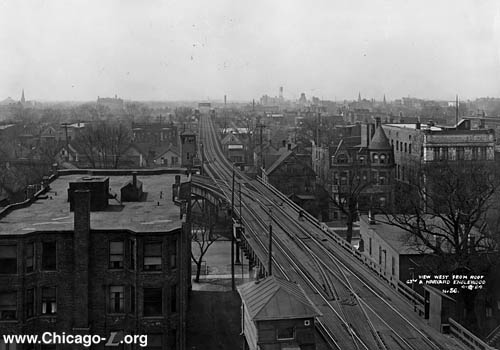|
|
|
|
|
|
|
|
|
|

Stewart Junction is seen looking west on April 18, 1924, with the Englewood branch continuing straight west and the Normal Park branch diverging to the south at the left. Stewart Tower is in the center of the photo, beyond the junction. Parnell station is visible in the distance. The building in the bottom center of the photo is most likely a shanty for the switchmen assigned to this location to facilitate the adds and cuts of Normal Park cars from and to the Englewood trains. Note the small shelter with bench just opposite which would have been for the switchmen on the cutting side of the tracks, and two signs along the track that say "Single Cut Stop" and "Double Cut Stop". For a larger view, click here. (Photo from the CTA Collection) |
Stewart
Junction
Stewart Avenue and 63rd
Street, Englewood
Service Notes:
Services:
Englewood/Normal Park branches
Quick Facts:
Established: May 25, 1907
Original Line: South Side Elevated Railroad, Englewood/Normal Park branches
Rebuilt: n/a
Status: Demolished
Profile:
Stewart Junction was established on May 25, 1907 when the Normal Park branch opened, extending from a connection with the Englewood branch near Stewart Avenue and 63rd Street to 69th Street and Normal Boulevard. The junction between the Normal Park and Englewood branches at Stewart was an interlocked junction controlled by a tower. The tower was a wooden structure adjacent to the tracks, located on the south side of the right-of-way west of the junction. The junction consisted of a double-tracked turnout, with the main line of the Englewood branch continuing straight west and the Normal Park branch diverging to the south, and a right-hand crossover on the main line immediately east of the junction. All switches were interlocked and controlled by the tower.
Through most of the junction's history, Normal Park cars were coupled to Englewood trains at Harvard, the first station east of the junction, for the trip to downtown and cut off of trains from downtown at the same location. This continued largely unchanged for over 40 years until the CTA instituted its North-South Route service revision on July 31, 1949, which reduced the Normal Park service to a shuttle between 69th and Harvard only, served by a single wood car.
Despite the reduction in service levels, Stewart Tower continued to be staffed to accommodate the moves necessary for the Normal Park shuttle to move in and out of Harvard station without fouling the mainline service. Because there was no separate stub track or shuttle platform, it was necessary for the Normal Park trains to enter the Englewood main tracks in order to transfer passengers at Harvard. The transfer was effected at the inbound Harvard platform, with trains Normal Park entering the station as they normally would on the northbound track. Once passengers were discharged and boarded, the motorman would change ends and shuttle trains then went a short distance against traffic (under the protection of the tower) and crossed to the southbound track via the right-hand crossover between the station and the junction before re-entering the Normal Park Branch. The towerman at Stewart Tower performed these moves.
As Normal Park ridership continued to decline, service was reduced further. Effective May 18, 1952, all Saturday, Sunday, holiday and midday service on the Normal Park was discontinued, reducing service to weekday rush periods only. Finally, on January 29, 1954, all Normal Park service was discontinued, effectively closing Stewart Junction. Besides the low ridership, CTA also cited an improvement to the though-service of Englewood-Howard trains, which ran at close intervals on the main line, as a benefit to the closure, as it eliminated what CTA termed an "undesirable switching operation at the Harvard station which sometimes caused delays to through trains."1
Work began on May 19, 1954 to demolish the Normal Park branch. The work, contracted to the Doppelts Scrap Iron & Metals Company, included the interlocking tower at Stewart Junction. However, some equipment from the tower was salvaged for use at other rapid transit locations.2
|
|